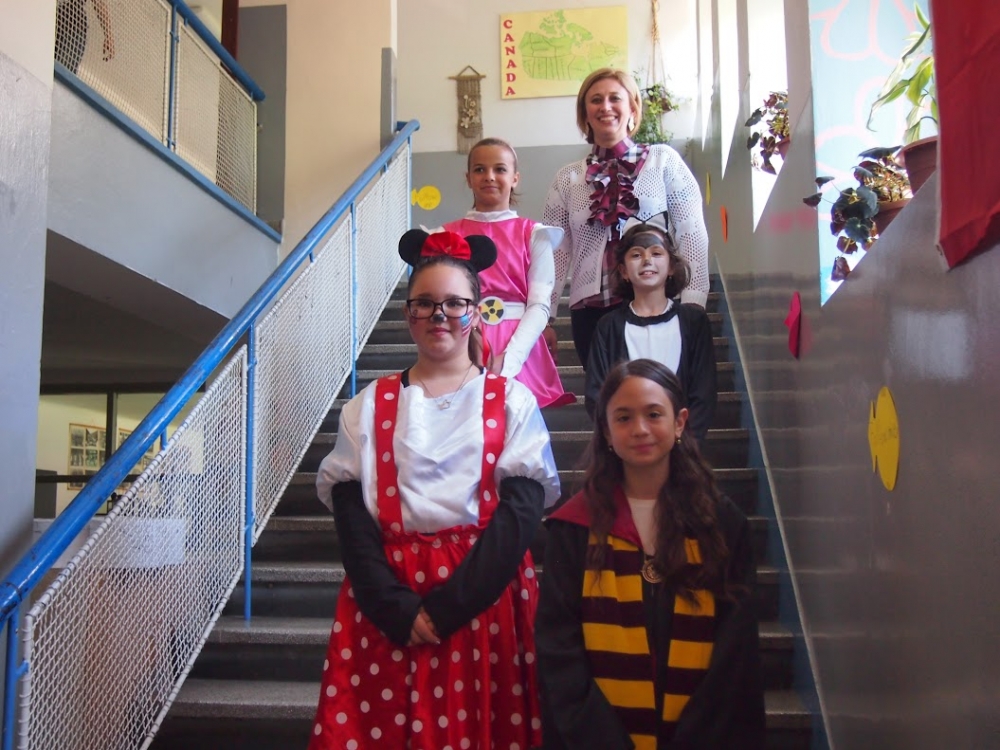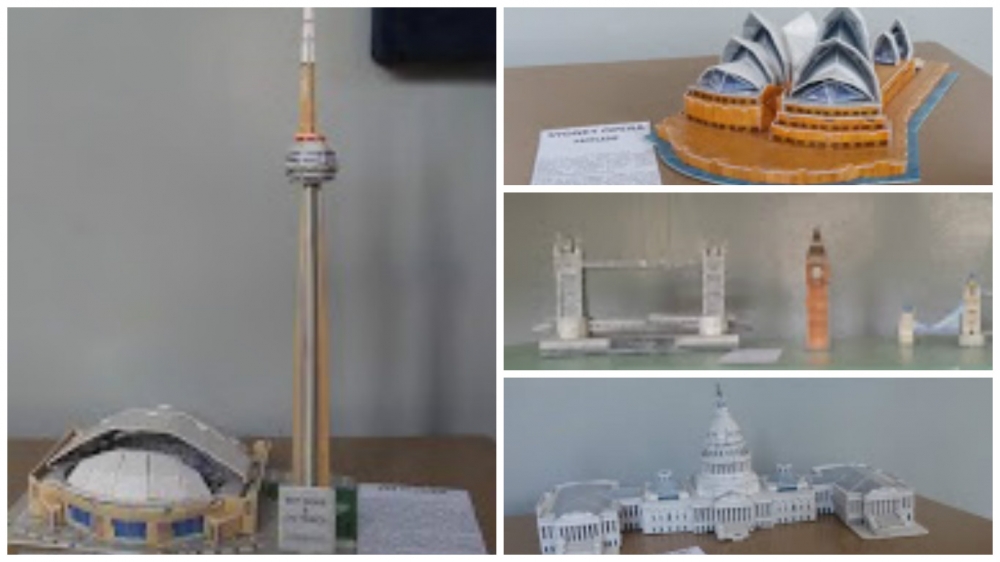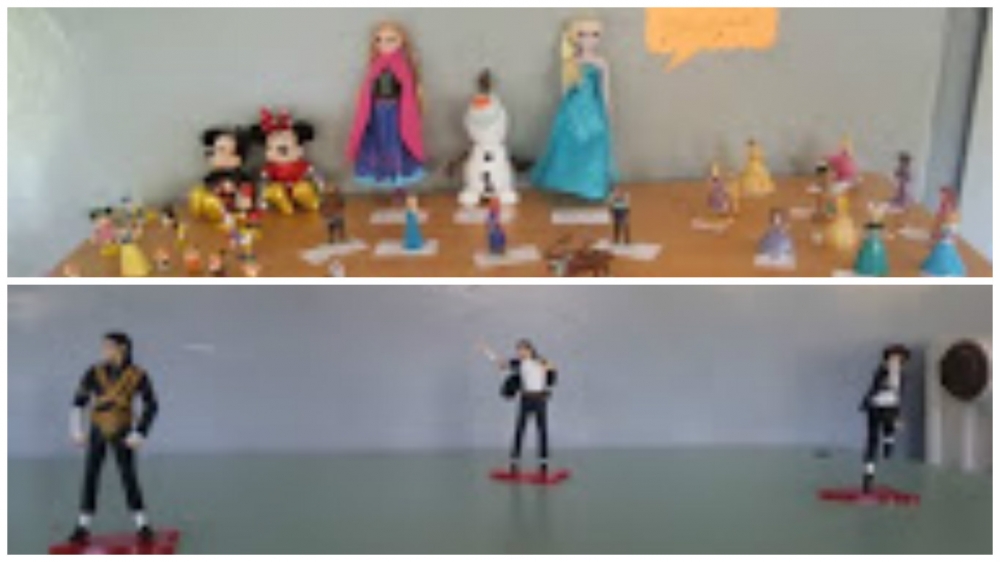|
There is no better way of learning about a country than through
its culture; I did just that with my pupils, and they loved it. We did a
cultural project that lasted a whole month, with a different
English-speaking country presented each week. The United Kingdom (UK; to
include Great Britain and Northern Ireland), the United States of
America (USA), Australia, and Canada were our destinations.
Each of the countries were assigned a guide: The UK was guided
by Roberta Vucinic, dressed like Hermione Granger from the Harry Potter book
series; the USA was guided by Valentina Alincic—or the best Minnie Mouse
on this side of the pond; the Australian guide was Vanja Vucinic, or a
famous cartoon character Felix the Cat; while
Canada was presented by Mirjam Golik, or our own Atomic
Betty.

The Guides
Each country had a grand opening, with the opening speech in
both English and Croatian so that all the pupils and teachers could
understand it. With the last sentence of the opening speech, the first
sounds of the national anthems would start, which was a great
opportunity for the pupils to listen to the four national anthems
unknown to them till that moment.
The guided tours started with an introduction to the guides and
an explanation for why those precise characters were chosen. There was a
welcome sign at the entrance with a figure or a photo of famous writers
from each country as well as the national animals and the official
flowers: So, the pupils met face-to-face with a bulldog, a bald eagle, a
kangaroo, and a beaver. They were greeted by the Bard himself (William
Shakespeare; UK), Ernest Hemingway (USA), Patrick White (Australia), and
Michael Ondaatje (Canada).

National animals and official flowers
Throughout the school corridors, there were posters hanging on
the walls offering pupils facts on geography, history, government,
educational systems, landmarks, film and music industries, TV shows,
literature, one important celebration for the country being guided,
traditional dishes, traditional stories and legends, and, finally, a
PowerPoint presentation to summarize the whole exhibition. Each
country's exhibition was enriched by many paper models of the famous
landmarks.

Famous landmarks
While the UK and the USA are well presented within our
coursebooks, that isn't a case with Australia and Canada. So this
project was an excellent way of providing pupils with new information on
those two beautiful countries. Besides the Sydney Opera House and
Sydney Harbour Bridge, which they were already familiar with, students
heard of Uluru, the Old Mill in Perth, the Wheel of Brisbane (which
reminded them of London Eye), Adelaide Gaol, and many more landmarks.
Canada was even more interesting, because they didn't know any landmarks
there except for Niagara Falls. It was also their opportunity to hear
about two of the most photographed hotels in the world—Château Frontenac
and the Fairmont Chateau Lake Louise—Confederation Bridge, Saint
Joseph's Oratory, and many more.
Before the project, my students knew only of Cambridge and
Oxford universities. Now they know of the Ivy League as well as the top
five universities in both Australia and Canada.
The most interesting for the younger pupils as well as children
from our neighbouring kindergarten was the Disneyland corner, while the
older pupils loved Michael Jackson's dancing figures.

Disneyland and Michael Jackson corners
While familiar with Shakespeare and Dickens as well as
Hemingway and Twain, the students heard for the first time some of the
greatest names of Australian and Canadian literature. They have “met”
Banjo Paterson, Ethel Turner, and Patrick White while travelling through
the country Down Under. They have also met Michael Ondaatje, Alice
Munro, and Carol Shields while visiting the second largest country (by
area) in the world.
There was one special poster that presented an important date
or event for each of the countries. There was a green poster to present
Saint Patrick's Day (UK); a black one to show our sorrow and sympathy
for all the victims of September 11th, 2011 (USA); a red one to
represent the colour of poppies, which symbolise Remembrance Day
(Australia), as well as another red one to celebrate Canada
Day.
The posters on traditional dishes were all around the kitchen's
door, and they included dishes such as fish and chips, Yorkshire
pudding, cottage pie, haggis, apple crumble, meatloaf, chocolate chip
cookies, damper, Pavlova, poutine, butter tart, and many more.
The stories and legends were where they should be—around the
library's door. The pupils could read about Finn MacCool and the Giant's
Causeway, the Gingerbread Boy, Rip van Winkle, the Navajo People, the
Dreamtime and Creation of life, as well as the legends of the Canadian
First Nations people.
The PowerPoint presentations were a great source for revisiting everything mentioned during the tour.
As a part of the month, there were two quizzes organized. The
first one was The music quiz, in which four groups of four pupils
representing each of the four upper classes had to listen to a song,
press their buzzers as quickly as possible, and try to guess the singer
or musical group performing the song. Each team was awarded a music
trophy. Two day s after that, the general knowledge quiz was held. It
consisted of 100 questions regarding everything students had learned
during the 4 weeks of the project. Students were awarded trophies and
something sweet. s after that, the general knowledge quiz was held. It
consisted of 100 questions regarding everything students had learned
during the 4 weeks of the project. Students were awarded trophies and
something sweet.
During the last day of the project, Conor Snowden, a director
of the British Council for Croatia and Slovenia, and Branka Zaja, the
British Council project coordinator, visited our school and were a part
of our cultural event. Mr. Snowden and Mrs. Zaja were, together with our
school headmaster, members of the decision-making committee in charge
of the buzzers and the validity of the answers provided by the pupils
for the general knowledge quiz.
On the last day of the month, pupils Michael Mladjenovic,
Valentina Alincic, and Roberta Vucinic acted out Michael's play called The Fisherman and the Silver Trout, which was based
on the traditional English folk tale, “Three Wishes. ”
Each week, there were guided tours for all of our guests,
including the pupils and the teaching staff from the neighbouring
Railway technical school, as well as the parents, grandparents, locals,
and members of the press. Essays and photographs have been sent to the
embassies of the countries included in the project, so they could see
how their countries were presented to the pupils in a small village
school.
Although we are a small village school with approximately 60
pupils, we are willing to learn new things and visit new places; meet
royalty, presidents, and prime ministers; watch films; listen to music;
read books in English; and much more. This project broadened pupils'
horizons, and they were faced with many new and interesting things. They
learnt to dance the English waltz as well as polka—Yes, I know it's a
Polish dance, but do you know that it is also the state dance of
Winsconsin? My pupils do!
If you want to learn things you haven't learnt so far about the
four English-speaking countries, visit us! If you want to learn the
English waltz, come and dance with us! If you like to read, come, and
we'll read together! And if you like delicious food...you can always
prepare it and we'll eat it together!
We may live in a small village, but we are the citizens of the
world. Come to our school and be a part of the global village,
too!
Davorka Nekic
has a BA in Croatian and English language and literature from the
Faculty of Humanities and Social Studies, University of Rijeka, Croatia.
She works in Nikola Tesla Primary School in Moravice, which is a part
of Ivan Goran Kovacic Primary School in Vrbovsko, Croatia. She has been
teaching for 8 years. She always tries to bring new ideas and resources
into her ELT.
|

